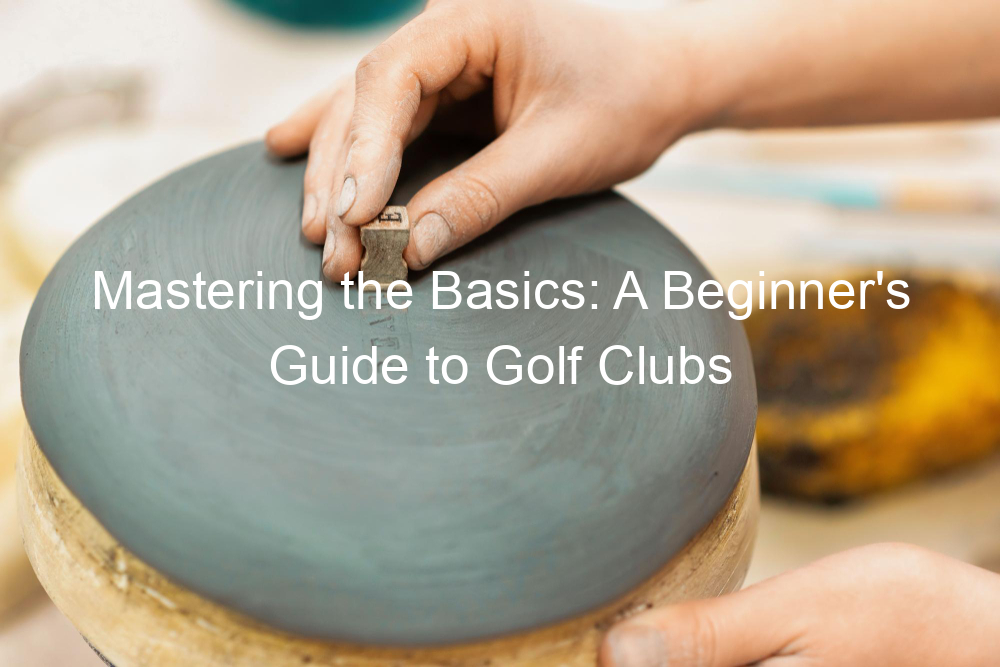Introduction to Golf Clubs
In this section, we’ll explore the importance of golf clubs and provide a simple explanation for beginners.
-
- The Golf Clubs
Hitting the ball towards the hole can be a challenging task. Each club is designed with a specific purpose in mind, whether it’s driving the ball a long distance, getting it out of a tricky spot, or putting it into the hole. The right club can make a significant difference in your game.
-
- Golf Clubs Explained
There are mainly four types of clubs: drivers, irons, wedges, and putters. Drivers are used for long-distance shots, irons for shorter distances, wedges for very short and high shots, and putters for rolling the ball into the hole. Each club has a different design and is used in different situations on the golf course. As you play more, you’ll get a feel for which club to use when.
A game of skill and strategy, and the right club can help you navigate the course and improve your score. So, take the time to understand your clubs and how to use them effectively.
Types of Golf Clubs and Their Uses
Each club has a unique design and purpose, which can significantly impact your game. Let’s delve into the world of golf clubs and learn how to use them effectively.
-
- Overview of golf clubs types and uses
There are primarily four types of golf clubs: woods, irons, hybrids, and putters. Each type is designed for specific shots and situations on the golf course.
Woods are used for long-distance shots, typically off the tee. They have a large head and a long shaft, which allows for maximum power and distance.
Irons come in a range of sizes, from 1-iron to 9-iron. They are used for a variety of shots, from the tee to the green, depending on their size. The lower the number, the longer the distance the ball can travel.
Hybrids are a combination of woods and irons, designed to be easier to hit than the traditional long irons. They are used for long shots that need more accuracy than a wood can provide.
Putters are used for short and low-speed strokes with the aim of rolling the ball into the hole from a short distance away.
-
- What golf club to use for each shot
The distance to the hole, the position of the ball, and the conditions of the course. Here are some general guidelines:
For long-distance shots from the tee or fairway, a wood or a hybrid is usually the best choice. The specific club will depend on the exact distance and the golfer’s skill level.
For medium-range shots, an iron is typically used. The specific iron will depend on the distance to the hole and the golfer’s comfort with that particular club.
For short-range shots or shots near the green, a higher-numbered iron, a wedge, or a putter may be used, depending on the exact distance and the conditions of the green.
Golf Clubs for Distance
A significant difference in how far your ball travels. Golf clubs are best for achieving maximum distance and what professional golfers choose for their distance shots.
- What golf club to use for distance
Typically, the driver and fairway woods are the clubs that provide the most distance. These clubs have the longest shafts and the smallest angle of loft. The driver, also known as the 1-wood, is often used for tee shots as it’s designed to hit the ball the furthest. Fairway woods, such as the 3-wood and 5-wood, are versatile clubs that can be used for long shots on the fairway, as well as for tee shots on shorter holes.
It’s also about control and accuracy. A longer club can hit the ball further, but it’s also harder to control. Therefore, you need to balance the need for distance with the need for accuracy.
- Case study: Professional golfers’ choice for distance shots
For instance, Tiger Woods, one of the most successful golfers of all time, often uses a driver for his distance shots. He uses a TaylorMade SIM driver, which is known for its speed and distance capabilities.
On the other hand, Rory McIlroy, another top golfer, prefers to use a 3-wood for his long-distance shots. He uses a TaylorMade SIM2 Max fairway wood, which provides a great balance of distance and control.
| Golfer | Club for Distance Shots |
|---|---|
| Tiger Woods | TaylorMade SIM driver |
| Rory McIlroy | TaylorMade SIM2 Max fairway wood |
For distance shots depends on various factors, including the golfer’s skill level, the specific conditions on the course, and personal preference. You can make a more informed decision about which club to use for your distance shots.
Golf Clubs Types and Distances
- Exploring the correlation between golf club types and distances
Each type of golf club is designed for a specific purpose and can achieve different distances. For instance, drivers are used for long-distance shots, typically on the tee of a par-4 or par-5 hole, and can reach distances of 200-350 yards. Irons, on the other hand, are used for a variety of shots from teeing off on shorter holes, to chipping onto the green, and can achieve distances from 100 to 200 yards. Wedges are used for short shots, usually within 100 yards of the green, and putters are used for short and low-speed strokes with the intention of rolling the ball into the hole from a short distance away.
| Club Type | Average Distance (yards) |
|---|---|
| Driver | 200-350 |
| Iron | 100-200 |
| Wedge | Under 100 |
| Putter | Short distance |
- Example: How different golf clubs affect the distance of the shot
Let’s consider a practical example. Imagine you’re playing a par-4 hole. You would typically start with a driver to cover a large distance with your first shot. Then, depending on how far you are from the green, you might use an iron for your second shot. If you’re still a short distance away from the green after your second shot, you might use a wedge for your third shot. Finally, once you’re on the green, you would use a putter to get the ball into the hole.
The correlation between the type of golf club and the distance it can achieve, you can make more informed decisions during your game and improve your overall performance.
The Golf Clubs for Beginners
You might be wondering about the golf clubs you need to get started. The variety of clubs can be overwhelming, but don’t worry, we’re here to simplify it for you.
-
- What golf clubs do I need as a beginner?
You don’t need a full set of 14 golf clubs. Instead, start with a driver, a putter, a sand wedge, and supplement them with a 6-iron, an 8-iron, a pitching wedge, and a fairway wood or hybrid with 18-21 degrees of loft. These clubs are more forgiving and easier to hit as a novice.
- 7 golf clubs for beginners
-
- Driver: This is your main club for tee shots on longer holes.
- Putter: Used for putting the ball into the hole, this club is crucial for every level of play.
- Sand Wedge: It helps you escape the bunkers and is also useful for short shots to the green and for chipping around the green.
- 6-Iron: This is a middle iron and is used for shorter tee shots and approach shots into the greens.
- 8-Iron: It’s used for approach shots into the green and is easier to hit than longer irons.
- Pitching Wedge: This club is used for short approach shots into the greens, for chipping around the green and for playing out of bunkers.
- Fairway Wood or Hybrid with 18-21 degrees of loft: These clubs are used for longer shots from the fairway, and for tee shots on short par 4’s and long par 3’s.
The Golf Clubs with Pictures
Learning about golf clubs can be easier when you have pictures to guide you. Let’s dive into the world of golf clubs with some helpful visuals.
-
- Golf Clubs Explained with Pictures
There are several types of golf clubs, each with a unique design and purpose. Here’s a simple breakdown:
| Golf Club Type | Picture | Use |
|---|---|---|
| Driver |  |
Used for long-distance shots, typically on the tee box. |
| Iron |  |
Used for a variety of shots, from the fairway, rough, and even on the tee box for shorter holes. |
| Wedge |  |
Used for short-distance shots, typically near the green or to get out of sand traps. |
| Putter |  |
Used for putting the ball into the hole on the green. |
-
- Visual Guide: How to Identify Different Golf Clubs
Identifying golf clubs can be tricky, especially for beginners. Here’s a visual guide to help you:
-
-
- Driver: The driver is the longest club with the biggest head. It’s designed for power and distance. The head is usually round and large.
- Iron: Irons have a flat, angled face and a shorter shaft than drivers. They are numbered from 1 to 9, with 9 being the most lofted.
- Wedge: Wedges look similar to irons but have a more angled face for lofted shots. They are used for short game shots.
- Putter: Putters have a flat face and are used for rolling the ball on the green. They are the shortest clubs with a variety of head shapes.
-
The differences between these clubs, you’ll be better prepared to make the right choice during your game.
Conclusion: Mastering the Basics of Golf Clubs
As we wrap up this informative journey into the world of golf clubs, let’s recap the key insights we’ve gathered and outline the next steps on your golfing journey. The first step towards becoming a proficient golfer.
-
- Key takeaways for beginners
Used for distance and is typically the first club used in a round of golf. Irons, on the other hand, are versatile and used for a variety of shots, while putters are used for short and low-speed strokes.
You don’t need a full set of 14 clubs. Start with a driver, a putter, an iron, and a wedge. These are the essential golf clubs that will help you learn and improve your game.
-
- Next steps in your golfing journey
Now that you’ve mastered the basics, it’s time to put your knowledge into practice. Start by practicing your swing with each club. Each club requires a different swing technique.
Once you’re comfortable with your swing, try playing a few rounds of golf. Start on a beginner’s course and gradually work your way up to more challenging courses. Don’t be discouraged if you struggle at first. Golf is a challenging sport that requires patience and practice.
A rewarding and challenging sport. You’re well on your way to becoming a skilled golfer. Grab your clubs and hit the course!






